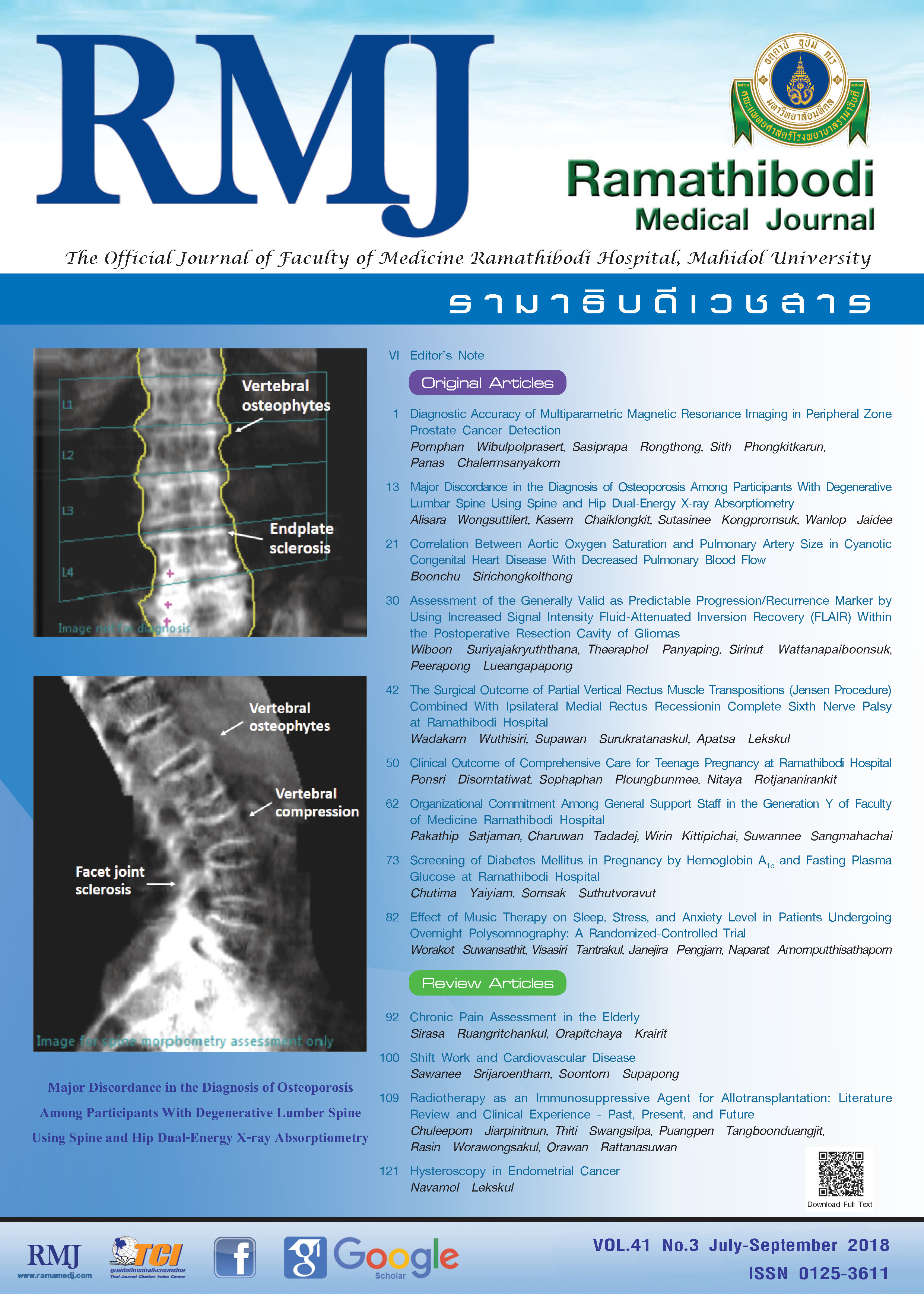Correlation Between Aortic Oxygen Saturation and Pulmonary Artery Size in Cyanotic Congenital Heart Disease With Decreased Pulmonary Blood Flow
DOI:
https://doi.org/10.14456/rmj.2018.30Keywords:
Cyanotic congenital heart disease, Pulmonary artery branches, Oxygen saturation, McGoon ratio, Nakata indexAbstract
Background: One of the indications for surgical planning in cyanotic congenital heart disease patients is the appropriate pulmonary artery size. Patient must be evaluated by an expert and in need of high-technology instruments. This is a limitation in situation with long waiting list of cardiac surgery.
Objective: To find the correlations between McGoon ratio/Nakata index and aortic oxygen saturation in patients with cyanotic congenital heart disease with decreased pulmonary blood flow, and to identify the appropriate oxygen saturation for planning the surgical repair.
Methods: The author reviewed angiograms of the patients who had cardiac catheterization at Thammasat Hospital from 2008 to 2017. The McGoon ratio and Nakata index were calculated and correlated to the aortic oxygen saturation by using the Pearson product moment correlation (r). The oxygen saturations that correspond to the surgical criteria values of McGoon ratio/Nakata index were estimated by using linear regression analysis.
Results: A total of 100 cardiac catheterizations were performed in 82 patients. The correlation between McGoon ratio/Nakata index and aortic oxygen saturation were moderately correlated (r = 0.61 and r = 0.46 respectively). The patients were divided into 3 groups. Prediction of the oxygen saturations that corresponded to the surgical values of McGoon ratio and Nakata index were 73.47% (95% confidence interval [CI], 70.34 -76.62) and 75.87% (95% CI, 72.41 - 79.33) in Biventricular repair group, 76.23% (95% CI, 73.76 - 78.70) and 76.73% (95% CI, 74.24 - 79.23) in Univentricular repair without Glenn operation group, 82.29% (95% CI, 79.87 - 84.70) and 85.03% (95% CI, 81.57 - 88.49) in Univentricular repair with previous Glenn operation group, respectively.
Conclusions: In this study, the lowest value of 95% CI of the predicted oxygen saturation in each group is selected to determine the patient who is not benefit to further investigation for total correction or Glenn/Fontan operation. For the Biventricular repair group, total correction should not be considered if oxygen saturation is less than 70%. In the Univentricular repair without Glenn operation group and the Univentricular repair previous Glenn operation group, the Glenn/Fontan operation should not be considered if oxygen saturation is less than 74% and 80%, respectively.
References
Piehler JM, Danielson GK, McGoon DC, Wallace RB, Fulton RE, Mair DD. Management of pulmonary atresia with ventricular septal defect and hypoplastic pulmonary arteries by right ventricular outflow construction. J Thorac Cardiovasc Surg. 1980;80(4):552-567.
Griod DA, Rice MJ, Mair DD, Julsrud PR, Puga FJ, Danielson GK. Relationship of pulmonary artery size to mortality in patients undergoing the Fontan operation. Circulation. 1985; 72(3 Pt 2):II93- II96.
Zuberbuhler JR. Tetralogy of Fallot. In: Emmanouilides GC, Riemenschneider TA, Allen HD, Gutgesell HP, eds. Moss and Adams - heart disease in infants, children, and adolescents including the fetus and young adult. 5th ed. Baltimore: Williams & Wilkins; 1995:998-1017.
Fontan F, Fernandez G, Costa F, et al. The size of the pulmonary arteries and the results of the Fontan operation. J Thorac Cardiovasc Surg. 1989;98(5 Pt 1):711-779.
Nakata S, Imai Y, Takanashi Y, et al. A new method for the quantitative standardization of cross-sectional areas of the pulmonary arteries in congenital heart diseases with decreased pulmonary blood flow. J Thorac Cardiovasc Surg. 1984;88(4):610-619.
Hinkle DE, Wiersma W, Jurs SG. Applied Statistics for the Behavioral Sciences. 5th ed. Boston: Houghton Mifflin; 2003.
Klandima S, Kirawittaya T, Pethdumrongsakul A, et al. Preoperative angiographic evaluation of the pulmonary arterial size in tetralogy of Fallot: comparison the McGoon ratio and Nakata index. Thai Pediatr J. 2006;13:178.
Lebecque P, Shango P, Stijns M, Vliers A, Coates AL. Pulse oximetry versus measured arterial oxygen saturation: a comparison of the Nellcor N100 and the Biox III. Pediatr pulmonol. 1991;10(2):132-135.
Schmitt HJ, Schuetz WH, Proeschel PA, Jaklin C. Accuracy of pulse oximetry in children with cyanotic congenital heart disease. J Cardiothorac Vasc Anesth. 1993;7(1):61-65. doi:10.1016/1053-0770(93)90120-A.
Griksaitis MJ, Scrimgeour GE, Pappachan JV, Baldock AJ. Accuracy of the Masimo SET® LNCS neo peripheral pulse oximeter in cyanotic congenital heart disease. Cardiol Young. 2016;26(6):1183-1186. doi:10.1017/S1047951115002188.
Ramachandran S, Gera A, Gera R, Kataria S, Pratim Roy M. Accuracy of pulse oximetry versus arterial blood gas in screening cyanotic heart. Int J Contemp Pediatr. 2016;3(3):983-987.

















